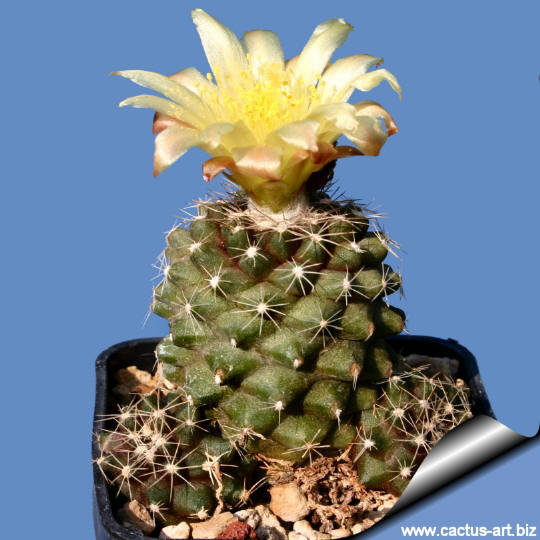|
|
|

Copiapoa tenuissima
Small growing and easy to to flower has a naturally dark body
with nicely contrasting bright yellow flowers.
|
 |
 |
|
. |
 |
 |
|
. |
 |
 |
|
. |

Photo by Jean-Yves Cretin (France) |

Flowers are yellow and opens in bright sun light |
|
Cultivation: Need full sun otherwise the bodies tended to elongate
in cultivation, but should be protected from excessive heat and sun in
summer, Require light watering, good drainage, and deep pot to
accommodate tap root. . Keep warm and dry in winter to avoid rot. Frost
tolerance 0°C
Propagation: Usually by
seeds. Heads can be
used as cuttings. They grow slowly at first until they develop the large
tuberous root. Grafting is also used to speed
growth rate and to create a back-up to plants in collection.
|
|
Advertising
|
|
|
|
|
Family:
Cactaceae (Cactus
Family)
Scientific name:
Copiapoa tenuissima
F.Ritter, (nom.. inval. Art. 37.1)
In: Taxon 12(1):29 1963
(First mentioned in Backeberg, Die Cact. 6: 3840, 1962 (as nom. nud.)
Origin: Northern Chile, Antofagasta
Habitat:
Native to the coastal deserts on the steep
mountain base among fragmented stones.
The long tuberous root of this
copiapoa is buried deeply in these soils which are very poor in organic
matter. In the area where this plants grows there is very little rain
but frequent coastal fog, which provides a significant part of their
water needs. The common
presence in habitat of plants with juvenile spination forms on old
taproots is due to the frequent grazing damage inflicted by donkeys and
Guanacos.
Synonyms:
- Copiapoa hypogaea ssp tenuissima (Ritter ex Hunt)
Hunt 2003
NOTE: As the original
description is invalid, this is the actual basionym for the taxon.
Copiapoa humilis var. tenuissima (F. Ritter) G. J. Charles
1960 (n. val. publ.)
Conservation status:
Listed in
CITES appendix 2.
|
|
Description: Single headed or slowly clumping,
usually at or slightly below soil level.
Stems: Up to 5 cm in diameter, flattened to spherical,
dull-green, dark olive green, to almost purplish-black. The stem is
tubercled rather than ribbed stem and the slightly felted apex can be
regarded as persistent juvenile characters, which can be explained by
the need for the plant to multiply as early as possible, before they
fall victim to the Guanacos.
Roots: Large tuberose connected to the stem by
long slender neck. Seedlings naturally produce the huge tap root,
starting from germination, i.e. before the plant stem becomes mature.
Ribs: 13-16 spiralling, 3-4 mm tall.
Areoles: White abundantly woolly.
Radial spines: Very thin (almost hairy), acicular, usually
straight 8-14, 3-6 mm long, yellowish to blackish.
Central spines: 0-1 (-2) 4-10 mm long.
Flowers: Pretty, yellow diurnal, up to 2.5 cm long. Tepals up to
15 mm long 5-7 mm wide. Ovary with pubescent scales, floral tube 4-7 mm
long. The flowers are supposedly to be sweet scented. (The hairy ovary
and fruit are a link with Ritter's Pilocopiapoa solaris)
Blooming season: Spring and summer. In
cultivation in the C. tenuissima are able to flower from immature stems
at an early age (c. 2 years from germination) and set viable seed.
Fruit: Globose, green to maroon unusual for the genus by being
woolly, a primitive characteristic.
|
|
|
|


Photo of conspecific taxa, varieties,
forms of plants
belonging to the Copiapoa humilis/taltalensis
complex
(This
Taxon has lots of synonyms (like most copiapoas)
with several controversial varieties and subspecies):


|
|